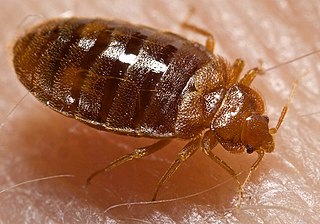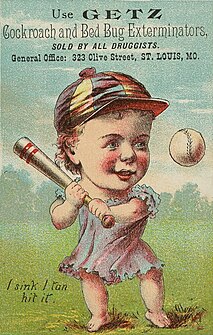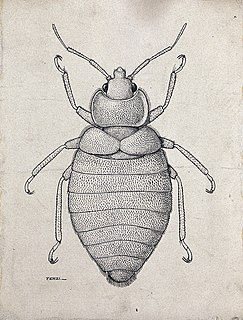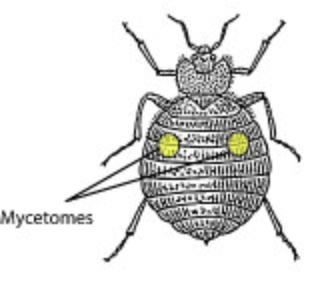
The Hemiptera or true bugs are an order of insects comprising some 50,000 to 80,000 species of groups such as the cicadas, aphids, planthoppers, leafhoppers, bed bugs and shield bugs. They range in size from 1 mm (0.04 in) to around 15 cm (6 in), and share a common arrangement of sucking mouthparts. The name "true bugs" is often limited to the suborder Heteroptera. Many insects commonly known as "bugs", especially in American English, belong to other orders; for example, the lovebug is a fly and the May bug and ladybug are beetles.

Cimexomys is an extinct North American mammal that lived from the Upper Cretaceous to the Paleocene. For a while, it shared the world with dinosaurs, but outlived them. It was a member of the extinct order Multituberculata and lies within the suborder Cimolodonta. It is perhaps a member of the Paracimexomys group, though it is not certain.
Pyrethrum was a genus of several Old World plants now classified as Chrysanthemum or Tanacetum which are cultivated as ornamentals for their showy flower heads. Pyrethrum continues to be used as a common name for plants formerly included in the genus Pyrethrum. Pyrethrum is also the name of a natural insecticide made from the dried flower heads of Chrysanthemum cinerariifolium and Chrysanthemum coccineum. Its active ingredient are pyrethrins.

Bed bugs are insects from the genus Cimex that feed on human blood, usually at night. Their bites can result in a number of health impacts including skin rashes, psychological effects, and allergic symptoms. Bed bug bites may lead to skin changes ranging from small areas of redness to prominent blisters. Symptoms may take between minutes to days to appear and itchiness is generally present. Some individuals may feel tired or have a fever. Typically, uncovered areas of the body are affected. Their bites are not known to transmit any infectious disease. Complications may rarely include areas of dead skin or vasculitis.

The Cimicidae are a family of small parasitic insects that feed exclusively on the blood of warm-blooded animals. They are called cimicids or, loosely, bed bugs, though the latter term properly refers to the most famous member of the family, Cimex lectularius, the common bed bug and its tropical relation Cimex hemipterus. The family contains over 100 species. Cimicids appeared in the fossil record in the Cretaceous period. When bats evolved in the Eocene, they switched hosts and now feed mainly on bats or birds. Members of the group have colonised humans on three separate occasions.

A detection dog or sniffer dog is a dog that is trained to use its senses to detect substances such as explosives, illegal drugs, wildlife scat, currency, blood, and contraband electronics such as illicit mobile phones. The sense most used by detection dogs is smell. The smell from the detection dogs are more enhanced than the average dog. They are trained to have this great sense of smell. Hunting dogs that search for game, and search dogs that work to find missing humans are generally not considered detection dogs. There is some overlap, as in the case of cadaver dogs, trained to search for human remains. A police dog is essentially a detection dog that is used as a resource for police in specific scenarios such as conducting drug raids, finding missing criminals, and locating stashed currency.

Cimex lectularius is a species of Cimicidae. Its primary hosts are humans, and it is one of the world's major "nuisance pests".

Deltamethrin is a pyrethroid ester insecticide.
Bat bugs are blood-sucking insect parasites that feed primarily on the blood of bats. The name has been applied to members of the family Cimicidae and also to members of the family Polyctenidae. Bat bugs are closely related to bed bugs, and are so similar in appearance that they are often mistaken for bed bugs. Microscopic examination is needed to distinguish them. Bat bugs will also bite humans if given the opportunity.
Cimex pilosellus, known generally as the bat bug or western bat bug, is a species of bed bug in the family Cimicidae. It is found in North America.

Traumatic insemination, also known as hypodermic insemination, is the mating practice in some species of invertebrates in which the male pierces the female's abdomen with his aedeagus and injects his sperm through the wound into her abdominal cavity (hemocoel). The sperm diffuse through the female's hemolymph, reaching the ovaries and resulting in fertilization.

Cimex is a genus of insects in the family Cimicidae. Cimex species are ectoparasites that typically feed on the blood of birds and mammals. Two species, Cimex lectularius and Cimex hemipterus, are known as bed bugs and frequently feed on humans, although other species may parasitize humans opportunistically. Species that primarily parasitize bats are known as bat bugs.

Use of DNA in forensic entomology refers to the focus in forensics on one of the three aspects of forensic entomology: urban, stored product and medico-criminal entomologies. This article focuses on medico-criminal entomology and how DNA is analyzed with various blood-feeding insects.
Bed bug or bed bugs may refer to:
In the 10th edition of Systema Naturae, Carl Linnaeus classified the arthropods, including insects, arachnids and crustaceans, among his class "Insecta". True bugs and thrips were brought together under the name Hemiptera.
Bed bugs occur around the world. Rates of infestations in developed countries while decreasing from the 1930s to the 1980s have increased dramatically since the 1980s. Previous to this they were common in the developing world but rare in the developed world. The increase in the developed world may have been caused by increased international travel, resistance to insecticides, and the use of new pest-control methods that do not affect bed bugs.

Hematophagy is the practice by certain animals of feeding on blood. Since blood is a fluid tissue rich in nutritious proteins and lipids that can be taken without great effort, hematophagy is a preferred form of feeding for many small animals, such as worms and arthropods. Some intestinal nematodes, such as Ancylostomatids, feed on blood extracted from the capillaries of the gut, and about 75 percent of all species of leeches, a free-living worm, are hematophagous. Some fish, such as lampreys and candirus, and mammals, especially the vampire bats, and birds, such as the vampire finches, hood mockingbirds, the Tristan thrush, and oxpeckers also practise hematophagy.

Bed bugs, or Cimicidae, are small parasitic insects. The term usually refers to species that prefer to feed on human blood.

Cimex hemipterus, known as the tropical bed bug, is a species of bedbugs within the cimicidae family that primarily resides in tropical climates. However, it has been reported that this species can live in more temperate climates along with the closely related bed bug species C. lectularius.C. hemipterus is a hematophagous, obligate parasite of humans. This means that it requires blood meals from their human hosts in order to survive. When bitten, humans experience itchiness, wheals, and lesions around the affected areas on the skin. This species typically resides in human domiciles within cracks, crevices, or mattresses, and are more prevalent in developing countries. Like other bed bugs, C. hemipterus is primarily active during the night time.

A mycetome is a specialized organ in a variety of animal species which houses that animal's symbionts, isolating them from the animal's natural cellular defense mechanisms and allowing sustained controlled symbiotic growth. In several species, such as bed bugs and certain families of leech, these symbionts are attached to the gut and aid in the production of vitamin B from ingested meals of blood. In insects, the organisms that inhabit these structures are either bacteria or yeasts.











